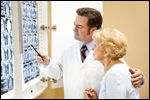Avoiding the Under- and Over-treatment of Breast Cancer in the Elderly
Dr. Muss and his colleagues investigated the use of adjuvant chemotherapy in patients with lymph node-positive breast cancer to determine if older people got the same "bang for the buck" as younger people when given more aggressive modern regimens.
The most significant risk factor for developing breast cancer, other than being a woman, is age.
In fact, the average age of diagnosis in the U.S. is now 63, which leaves clinicians frequently navigating the fine line between under- and over-treating older patients, Hyman Muss, MD, noted in his talk at the Miami Breast Cancer Conference.
It is important to ensure that the "treatment is not as bad as the disease," said Dr. Muss, director of geriatric oncology at the University of North Carolina's Lineberger Comprehensive Cancer Center, in Chapel Hill. "We shouldn't get a 1% improvement in survival, with a 1% increased risk of leukemia as a trade-off."

The average 70-something patient already carries 3 co-morbidities, and most elderly women with breast cancer actually die from a non-cancer cause-even those with node-positive disease.
While doctors should keep this vulnerability in mind, those who are overly conservative and withhold aggressive therapy could also miss an opportunity to add quality years to a patient's life, added Dr. Muss.
Fortunately, new research offers some advice for confronting this oft-ignored predicament.
Dr. Muss and his colleagues investigated the use of adjuvant chemotherapy in patients with lymph node-positive breast cancer to determine if older people got the same "bang for the buck" as younger people when given more aggressive modern regimens (doi: 10.1001/ jama.293.9.1073).
They found no association between age and disease-free survival among a large group of patients. Further, the more treatment older patients received the better they appeared to fare.
More recently, the team compared standard adjuvant chemotherapy to capecitabine in patients aged 65 and older (doi: 10.1056/NEJMoa0810266). The capecitabine group ended up with double the rate of disease recurrence compared to the standard regimen (P < .001): 68% vss 85% relapse-free survival at 3 years.
But the key, noted Dr. Muss, was that "standard chemotherapy did a very good job," particularly for patients with endocrine receptor-negative tumors-mostly cases of triple-negative disease.
"I believe older patients in generally good health with triple-negative disease should get the best possible chemotherapy," he said.
Based on current results from the ATAC (Armidex, Tamoxifen, Alone or in Combination) trial, the same may not be said for older women with low to moderately low recurrence scores. Very little evidence emerged for an added value of chemotherapy.
Endocrine therapy alone, specifically tamoxifen, has proven to be a "slam dunk" for people over 70, resulting in almost a 40% reduction annual risk of dying of breast cancer, noted Dr. Muss.
"You don't necessarily have to be a big hurry with a lot of these people," he added. Older patients tend to have slightly smaller and less aggressive tumors. Still, about 15% of patients over age 70 do present with triple-negative disease.
The bottom line: "Life expectancy, not age, is key in the treatment decision," according to Dr. Muss, who recommends using Adjuvant! Online to get an estimate of life expectancy based on a patient's condition and co-morbidities.
"If they are in good shape," he said, "then you should treat them like younger patients."
Gedatolisib Combo With/Without Palbociclib May Be New SOC in PIK3CA Wild-Type Breast Cancer
December 21st 2025“VIKTORIA-1 is the first study to demonstrate a statistically significant and clinically meaningful improvement in PFS with PAM inhibition in patients with PIK3CA wild-type disease, all of whom received prior CDK4/6 inhibition,” said Barbara Pistilli, MD.